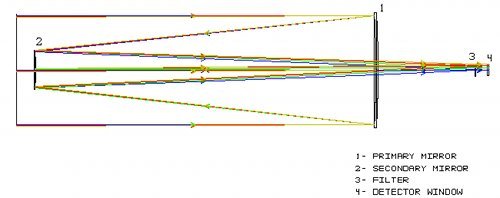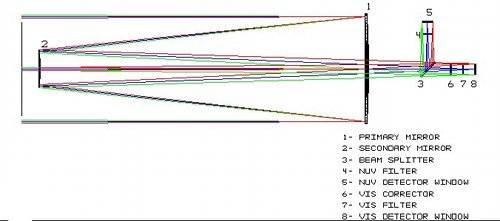UVIT Optics
Both the telescopes have hyperbolic f/4.5 primary mirrors of optical diameter ~375 mm, and hyperbolic secondary mirrors of optical diameter 140 mm. The overall focal length of the telescopes is ~ 4750 mm. The reflective coatings are Al with MgF2 layer. The expected reflectivity is about 70% per surface in FUV, and more than 80% per surface in NUV & VIS. Roughness of the coated surfaces is less than 1.5 nm rms, scattering below 1% per surface.
Optical layout of both the telescopes are shown below. The filters, each of diameter 50 mm, and the grating (only for FUV and NUV channels) are mounted in a wheel at a distance of ~ 40 mm from the detector. In the NUV/VIS telescope, a beam splitter is used to reflect NUV and transmit VIS. Transmission leads to aberration in the VIS beam, and a cylindrical lens in used to reduce the aberration below 2" FWHM. The plate scale is 21.6"/mm. With a surface figure better than 1/50 waves (at 632 nm) for each of the mirror the PSF includes more than 60% energy in diameter 1" at all wavelengths.

Optical layout of the FUV telescope: The filters, each of diameter 50 mm, and the grating are mounted in a wheel at a distance of ~40 mm from the detector.

Optical layout of the NUV /VIS telescope. A dichroic beam splitter is used for spectral division of the beam in NUV (reflection) and VIS (transmission). The filters, each of diameter 50 mm, and the grating (only for the NUV channel) are mounted in a wheel at a distance of ~ 40 mm from the detector.
The plate scale is 21.6"/mm. With a surface figure better than 1/50 waves (at 632 nm) for each of the mirror the PSF includes more than 60% energy in diameter 1" at all wavelengths.
In the NUV/VIS telescope, a beam splitter is used to reflect NUV and transmit VIS. Transmission leads to aberration in the VIS beam, and a cylindrical lens in used to reduce the aberration below 2" FWHM